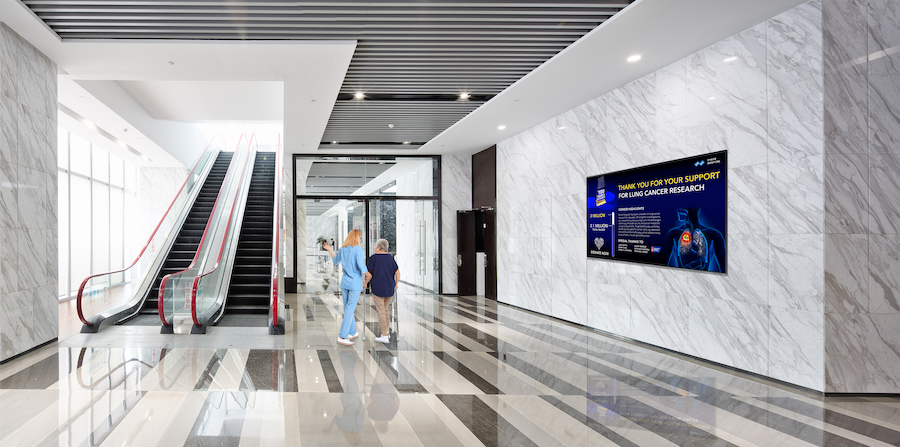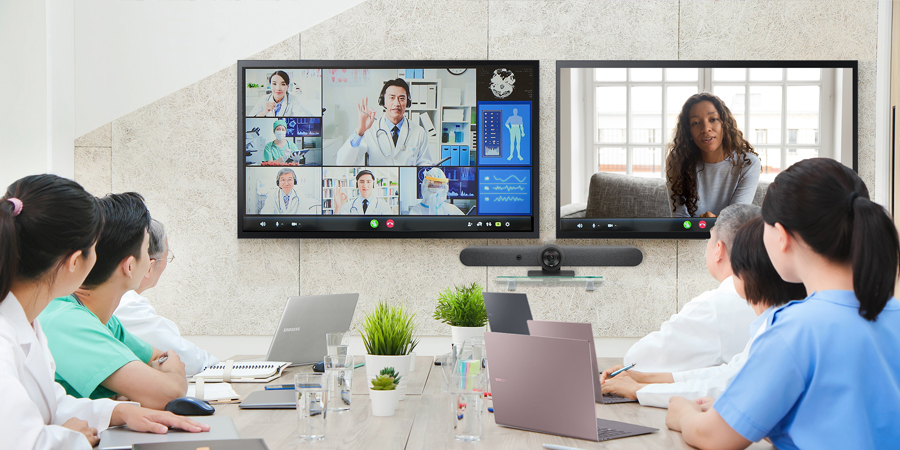People visiting medical centers are full of questions, concerns and a wide range of emotions, underscoring the importance of accurate, timely communications for patients, visitors and even staff.
Static printed signs can manage some basic communication needs, but healthcare providers increasingly need digital signage that can be quickly updated, enhancing the quality of their messaging and improving the patient journey.
Different types of displays, such as waiting room signs for patients, serve different needs in healthcare settings, and each can be tuned to the dynamics and demands of a particular location and use case.
Visually soothing nervous visitors and patients
At hospitals and other healthcare facilities, the questions and uncertainty start the moment patients and their loved ones enter the lobby. Thoughtfully planned digital content and waiting room signs with updated information can help calm their nerves.
By delivering hopeful and inspirational messages, your displays can reassure new patients that they’re in the hands of skilled and knowledgeable medical professionals. In waiting rooms, soothing digital art can also help patients relax into a better frame of mind.
A hospital’s first-time visitors may be particularly anxious and unsure of where to go or what to do, particularly in large multi-level or multi-building medical complexes. Digital signage technology can guide visitors as they move around the campus and offer them useful information about the services available at the facility. Visible displays in common areas can help raise awareness of events, other services and amenities like parking, resulting in more effective patient journey management.
Other healthcare systems load multiple languages into the display’s wayfinding app, allowing visitors to get the information they need in their first language and easing the strain on reception, where staff would otherwise need to find an available translator.
Digital wayfinders and directories can also be set up to multitask as marketing tools that, when they’re not in use, revert to a scheduled rotation of messaging — such as promotion for an upcoming public lecture. High-brightness and outdoor-ready displays can do the work in a sun-filled atrium or an outdoor plaza.
Improve patient outcomes and facility resilience
Boost operations, streamline communication and enable staff to enhance the overall patient experience. Download Now
Making the most of waiting areas
Medical centers are full of waiting rooms, in emergency departments, clinics, labs and diagnostic areas. Digital screens and waiting room signs for patients and visitors can address their needs and interests in a variety of use cases:
Queue management: Take-a-number slips are being replaced by check-in kiosk displays that register a patient’s arrival, notify the management desk and assign numbers that appear on screens in the waiting area. Samsung Kiosk is an out-of-the-box solution that hospitals can quickly implement to offload extra work for hospital staff and increase efficiency.
Distraction: Medical office waiting room signs can be effective tools for calming visitors who are concerned about the length of their wait time and for distracting them from what’s likely a situation of emotional unease.
Patient education: In condition-specific clinics — diabetes clinics, for example — waiting room signs for patients and screens in the waiting area can prepare patients and their loved ones by teaching them about a particular condition and the process of treating it. While it’s not a replacement for one-on-one conversations with caregivers, well-prepared on-screen content can cover common questions and allow doctor-patient visits to get to the specifics more quickly.
Facilitating healthcare worker communication
At care centers and nurses’ stations, clinicians frequently, and often frantically, have to use dry-erase boards to update rotating schedules and patient information. But as healthcare records become increasingly digitized, these whiteboards can now be replaced with digital dashboards.
Transitioning to high-resolution digital displays benefits healthcare facilities in more ways than one. Sloppy handwriting, for instance, is no longer an issue in interpreting information about a patient’s condition or treatment regimen. At a glance, digital dashboards keep clinical teams up to date on room assignments, care teams, patient status, restrictions and completion rates of assigned tasks. Importantly, they can be updated automatically when they’re integrated with real-time data from patient journey management systems.
Enhancing patient room signs
Outside the patient’s room, digital signage can help visitors locate a patient and let them know if the patient is temporarily in another room, perhaps getting an X-ray. Some displays, such as Samsung’s QMT Series, feature reliable, non-glare panels that provide better visibility from all angles. Built-in Wi-Fi and Bluetooth support personalized and interactive features.
Inside the patient room, the new HCU7030 and HCF8000 web-enabled televisions meet the rigorous standards for use in hospital environments. They include an integrated pillow speaker interface, superior visuals with 4K resolution and peak HDR (high dynamic range) performance for a more comfortable patient experience. These TVs are Web-RTC (real-time communication)-ready, which means they support videoconferencing. They also include Web-RTC for enhanced virtual healthcare assistance.
Recognizing contributions
Most medical centers rely on donations, both personal and corporate, to expand or upgrade their facilities, where donors are typically honored on engraved walls or an array of plaques. The advent of narrow-bezel LCD and direct-view LED video walls has allowed hospitals to elevate their donor recognition with high-profile feature walls. The Wall from Samsung, for example, can help hospitals celebrate their donors and volunteers by showcasing their heartfelt testimonials on a powerful microLED display. The stunning visuals fully immerse the viewer.
Improving the patient journey
Healthcare settings can be intimidating and bewildering, and a critical component of delivering better care and ensuring happier patients is effective, timely communication.
Find out more on how digital signage can be effectively used in the healthcare setting with this free guide to configuring and tailoring real-time messaging using an integrated content management system (CMS). Or, focus on increasing engagement along the patient journey with Samsung’s versatile range of interactive displays.









